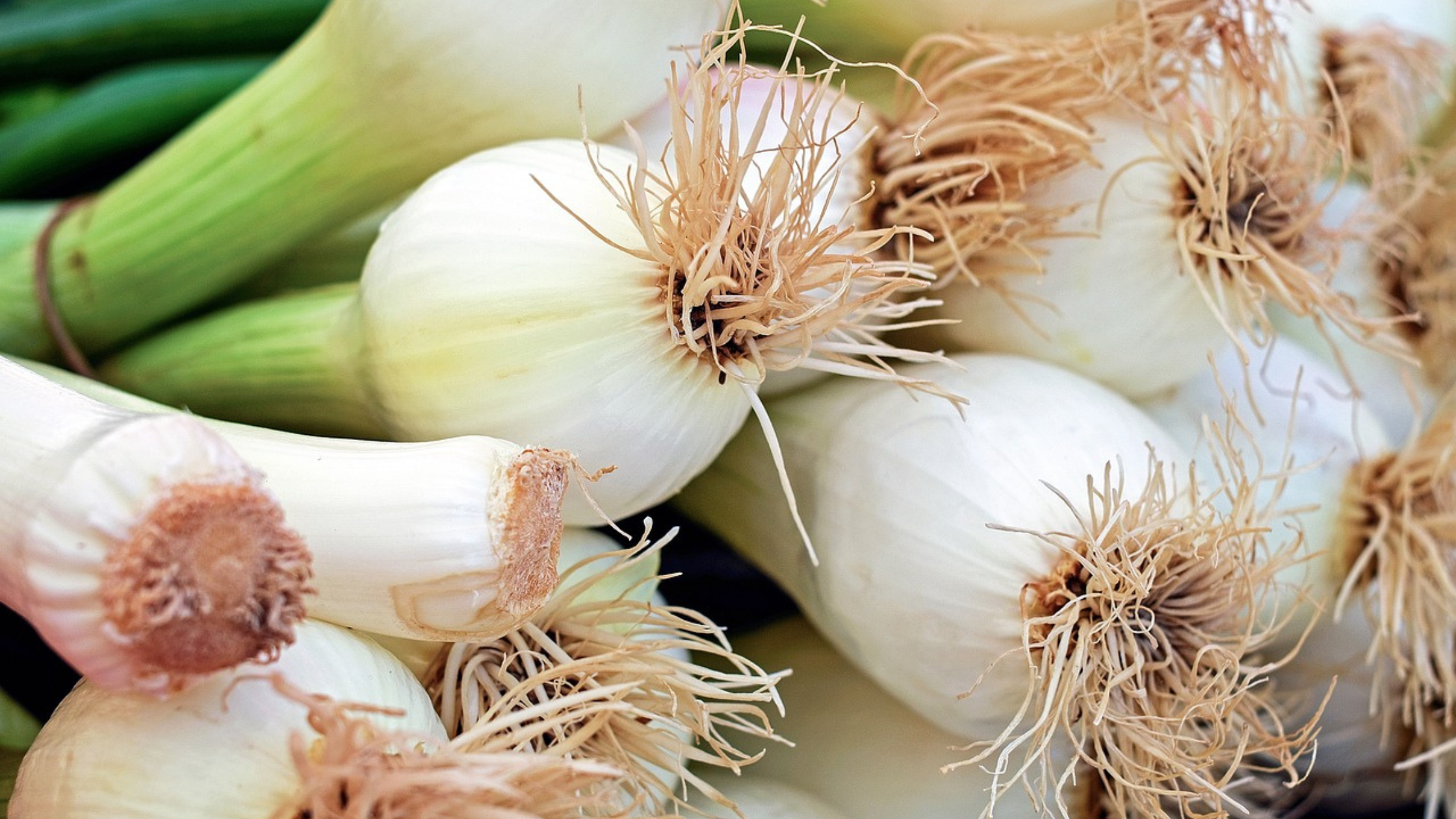Green onions, aka scallions or bunching onions, make a great flavor addition and garnish for just about any dish. Once you start growing your own at home, you’ll wonder why you ever bought the little bunches from the grocery store! They’re easy to grow and are a great option for gardeners with any amount of space, from just a pot on a windowsill to a whole backyard full of garden beds.
The versatility of green onions in the kitchen is widely known and loved. Chop ‘em up as a beautiful garnish on any dish, cook them into eggs for a light oniony flavor in your next omelet, throw them in soups, or roast them whole with asparagus and a little salt and olive oil! Just delicious. To get an endless supply of these incredible alliums in your home, all you have to do is grow them!
How to Grow Green Onions from Seed
Green onions are a hardy, low-maintenance crop that mainly need plenty of sun and rich, well-draining soil. Make sure to amend your garden bed with an inch or two of compost before planting, or use a high-quality potting mix if you’re growing in a container.
Planting Green Onion Seeds
Green onion seeds should be planted indoors eight to ten weeks before your last frost. We start them this early in order to get a jump on the season, and make sure we’ve got green onions all summer long. Alternatively, they can be direct seed outdoors throughout the summer and fall. They tend to grow best in cooler temperatures, but a little afternoon shade will help them survive the intense summer heat. While they are somewhat frost-tolerant, they will not tolerate prolonged periods of below freezing temperatures, so consider using some type of season extension if you want to be harvesting your green onions into the winter.
When planting green onion seeds, they should be sown ¼ inch deep and one inch apart. They can be thinned to one to two inches as they mature but do not need to be. In fact, we recommend planting your green onions in clumps as young plants can be easily knocked over; growing in clumps will help hold them up as the maturing seedlings will support each other as they grow! Typically, green onion seeds will take one to two weeks to germinate. Keep them evenly moist and utilize best practices for starting seeds.
Planting Green Onions
If starting your green onions indoors, you’ll likely need to eventually transplant them. Onions have tiny, threadlike, delicate sprouts that can be easily damaged, so, when transplanting, take care not to disturb the roots too much. You can use a widger to separate a clump and plant those directly into the garden. We recommend planting your clumps six inches apart.
Green onions can be transplanted outdoors two to four weeks before your last frost. If you’re direct seeding outside, ensure that your soil temperature is at least 50 degrees Fahrenheit so that you get good germination.

Caring for Your Green Onions
Overall, green onions are a low-maintenance crop! Some people like to hill up the soil around their scallions as they grow to get more white stem and less greens, but that’s just a matter of preference. Soil moisture is an important consideration though, since green onions have shallow root systems. Pay close attention and make sure to water as soon as the top half-inch or so of soil is dry. But, be careful not to leave the soil waterlogged for too long. It should be consistently moist, not soggy. Applying a liquid fertilizer like fish emulsion occasionally can give your green onions a boost. Green onions tend not to be bothered by too many pests, and a three-year crop rotation is good prevention for most of the diseases and insects that affect them. Snails and slugs can do a number on young plants however, so try to water in the morning and avoid leaving the soil surface wet overnight. Beer traps are a great non-toxic way to reduce slug and snail numbers if they are a problem in your garden.
Harvesting Green Onions
Green onions can really be harvested at just about any stage (some people even grow them as microgreens!) Most gardeners begin harvesting their scallions when the stalks reach pencil thickness or more. If you’re growing your onions in clumps, pull up just one or two onions from each group at a time, to allow the others more space to grow. Many green onion varieties will get quite large if left in the ground long enough, up to 18 inches tall and a couple inches in diameter! If you only want the greens on the other hand, just clip them off about an inch or two above the soil line, and leave the roots in the ground. They’ll re-sprout more greens! If you see your plants putting up a central stalk with a bud on the end, that means they’re beginning to bolt (flower), and you should harvest them right away. (And eat the flower stalk, or “scape,” too - they’re tasty, just like garlic scapes!) Green onions won’t taste very good after flowering, and will die soon after. Consistent watering and a little shade in the heat of summer will hold off bolting for as long as possible.
Tips for Growing Green Onions in Containers
Green onions are great for growing in a container, since their roots don’t grow very deep, and the plants can be harvested at any size. You’ll want your pot or grow bag to be at least six inches deep and have good drainage to avoid rotting the bulbs. Choose a high quality soil mix that is high in organic matter. If you’re container gardening indoors, you’ll want to keep your pot in a south-facing window that gets plenty of sunlight. Alternatively, you can invest in a good grow light.

Common Problems Growing Green Onions
Green onions tend to be pretty resilient, but like any crop, they have their signs of stress to watch out for!
Too Hot or Too Cold
If the edges of your green onion leaves are starting to brown and get a little crunchy - this is your crop trying to tell you they’re too hot! Try moving their container to a shadier spot or if they’re growing in the ground, set up some afternoon shade for them if you can. If the leaves start to get dark and mushy, this is your sign it’s a little too cold for them. Harvest immediately or cover with row cover or a cold frame to extend their season.
Too Much or Not Enough Water
The watering dance can be a delicate process. Too little water will result in dried out, crispy leaves while too much can result in a soggy onion with limp leaves. Keep in mind that the roots of green onions are quite shallow so there’s no need to drown them. But if you keep running into this issue, test the water (pun intended) and see what watering schedule suits your green onions best.
Green Onions not Maturing
Are your green onions stunted? This can sometimes be a problem. It could be a result of quite a few different factors - watering issues, not enough sunlight, soil quality - we could keep going. If these don’t appear to be your problem, consider applying some fish fertilizer to get things moving again!
How to Store Green Onions
One good way to store your green onions is upright in a glass of water in the fridge. They may even keep growing a tiny bit! Cover the roots with water just so. Take care not to submerge them past the white part of the stem. Green onions also keep well chopped up and refrigerated in an airtight container. No matter how you choose to store them, the rule of thumb is to make sure the leaves are not soggy from washing when they go in the fridge. Stored properly, green onions will last in the refrigerator for about a week.

The Best Green Onion Varieties to Grow
Tokyo Long White Bunching
This Japanese bunching onion yields long, slender white stalks with a delicious and mild flavor. They are phenomenal for adding to soups and stir fries, and as a tasty garnish for any dish!
Evergreen Bunching Nebuka
This popular and reliable bunching onion produces long white stalks with a sweet, delicious flavor. They are hardy and slow-to-bolt, overwintering very well.
Red Beard
These gorgeous onions have red stalks with green tops and a wonderful, mild onion flavor. They can be harvested at any size, but if they’re allowed to grow to maturity, the tops can reach 27 inches in height, with as much as 12 inches of red stalk!
Ready to try growing your own green onions? Check out Sow True Seed’s collection of green onions (also known as bunching onions) on our website. We’re sure to have the perfect variety for your garden.

|
Article Written by: Hannah Gibbons |
|
About the Author: Hannah Gibbons, an employee at Sow True Seed since 2020, has nearly a decade of experience in the agricultural industry. Their passion for environmental education and regenerative agriculture has been the cornerstone of their work, aimed at making gardening accessible to all. |



